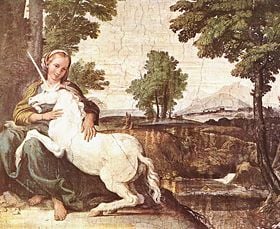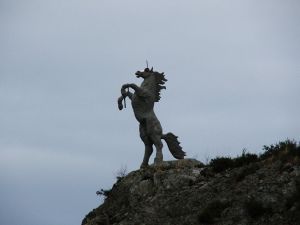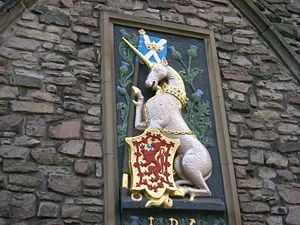Difference between revisions of "Unicorn" - New World Encyclopedia
Nick Perez (talk | contribs) |
Nick Perez (talk | contribs) |
||
| Line 15: | Line 15: | ||
==Origins== | ==Origins== | ||
| − | According to an interpretation of [[seal (device)|seals]] carved with an animal which resembles a [[Cattle|bull]] (and which may in fact be a simplistic way of depicting bulls in profile), it has been claimed that the unicorn was a common symbol during the [[Indus Valley civilization]], appearing on many seals. It may have symbolized a powerful social group. | + | Unlike most other legendary creatures, the unicorn was and, still is by some, believed to have been a real animal in the past. This may be due to the fact that physiologically, the unicorn is similar to animals that live in large groups in the wild and have regularly been hunted and revered by man, such as [[deer]], [[horse]]s, [[orynx]] and [[eland]]s. According to an interpretation of [[seal (device)|seals]] carved with an animal which resembles a [[Cattle|bull]] (and which may in fact be a simplistic way of depicting bulls in profile), it has been claimed that the unicorn was a common symbol during the [[Indus Valley civilization]], appearing on many seals. It may have symbolized a powerful social group. Other extinct creatures, such as the [[Elasmotheium]], an extinct relative of the [[rhinoceros]] that lived in the European [[steppe]] area many share similar physical characteristics with the unicorn, as does the [[narwhal]], which while a sea animal, has the only type of horn in nature that compares to that of the unicorn. Which, if not more than one, of these animals generated the myth of the unicorn, and how that myth became steadfastly believed by so many for so long remains a mystery. |
| − | + | Stories of the unicorn stretch back to [[ancient Greece]] from such sources as [[Herodotus]], [[Artistolte]] and Ctesias, although there seems to be little consistency between the three as to geographical location and whether the animal possessed magical powers. <ref> UnicornCollector [[http://www.unicorncollector.com/legends.htm ''Unicorns: The Complete Story of Unicorns Throughout the Ages'']] 1997-1998. Retrieved Jan. 30, 2007</ref> The unicorn appears in ancient [[Summerian]] culture, as well as throughout the [[Old Testament]] of the [[Bible]]. It is likely that these renditions all come from regionalized folklore and natural history. | |
| − | The | + | The origins of the unicorn in the East is a little different. The qilin of China is not similar in physicality to any naturally existing animal, and its signifigance in legends of justice and prophecy suggest that it is a completely fictious creature. This does not mean however, that the ancient Chinese did not believe in its exstince. Nor did ancient Indians who held onto the myth that a unicorn had saved India from invasion by [[Genhgis Khan]].<ref> UnicornCollector [[http://www.unicorncollector.com/legends.htm ''Unicorns: The Complete Story of Unicorns Throughout the Ages'']] 1997-1998. Retrieved Jan. 30, 2007</ref> |
| − | + | [[Image:Unicorn n22 kerry.jpg|thumb|right|Statue of unicorn]] | |
| − | '' | ||
| − | |||
| − | |||
==Cultural Depictions== | ==Cultural Depictions== | ||
[[Image:Französischer Tapisseur (15. Jahrhundert) 001.jpg|thumb|right|Tapestry, Maiden with Unicorn, 15th century,([[Musée de Cluny]], Paris)]] | [[Image:Französischer Tapisseur (15. Jahrhundert) 001.jpg|thumb|right|Tapestry, Maiden with Unicorn, 15th century,([[Musée de Cluny]], Paris)]] | ||
| + | |||
| + | An animal called the ''[[re'em]]'' is mentioned in several places in the [[Bible]], often as a metaphor representing strength. "The allusions to the ''[[re'em]]'' as a wild, untamable animal of great strength and agility, with mighty horns (Job xxxix. 9-12; Ps. xxii. 21, xxix. 6; Num. xxiii. 22, xxiv. 8; Deut. xxxiii. 17; comp. Ps. xcii. 11), best fit the [[aurochs]] (''Bos primigenius''). This view is supported by the Assyrian ''rimu,'' which is often used as a metaphor of strength, and is depicted as a powerful, fierce, wild, or mountain bull with large horns."<ref> ''Jewish Encyclopedia'': "unicorn".</ref> This animal was often depicted in ancient [[Mesopotamian]] art in profile with only one horn visible. | ||
| + | |||
Medieval knowledge of the fabulous beast stemmed from biblical and ancient sources, and the creature was variously represented as a kind of wild ass, goat, or horse. By C.E. 200, [[Tertullian]] had called the unicorn a small fierce [[Goat|kidlike]] animal, and a symbol of [[Christ]]. [[Ambrose]], [[Jerome]] and [[Basil the Great|Basil]] agreed. | Medieval knowledge of the fabulous beast stemmed from biblical and ancient sources, and the creature was variously represented as a kind of wild ass, goat, or horse. By C.E. 200, [[Tertullian]] had called the unicorn a small fierce [[Goat|kidlike]] animal, and a symbol of [[Christ]]. [[Ambrose]], [[Jerome]] and [[Basil the Great|Basil]] agreed. | ||
Revision as of 20:56, 30 January 2007
The unicorn, a legendary creature usually depicted with the body of a horse, but with a single – usually spiral – horn growing out of its forehead (hence its name – cornus being Latin for 'horn'), is one of the most revered mythical beasts of all time. Appearing in numerous cultures for centuries, the unicorn has come to be a symbol of purity and beauty, and is one of the few mythical creatures not associated with violence, danger and fear.
Overview
In the west, the image of the unicorn is in contrast with the classical depictions of a unicorn as having a billy-goat beard, a lion's tail, and cloven hooves, which distinguish him from a horse. In the East, the unicorn is depicted somewhat differently. Though the qilin (麒麟, Chinese), a creature in Chinese mythology, is sometimes called "the Chinese unicorn", it is a hybrid animal that looks less unicorn than chimera, with the body of a deer, the head of a lion, green scales and a long forwardly-curved horn. The Japanese "Kirin", though based on the Chinese animal, is usually portrayed as more closely resembling the Western unicorn than the Chinese qilin.
In both the East and West, the unicorn is a symbol of purity. Its horn is reported to neutralize posion and have healing powers. In medieval lore, the alicorn, the spiraled horn of the unicorn (the word "Alicorn" can also be the name for a winged unicorn/horned pegasus), is said to be able to heal and neutralize poisons. This virtue is derived from Ctesias's reports on the unicorn in India, that it was used by the rulers of that place to make drinking cups that would de-toxify poisons.
Origins
Unlike most other legendary creatures, the unicorn was and, still is by some, believed to have been a real animal in the past. This may be due to the fact that physiologically, the unicorn is similar to animals that live in large groups in the wild and have regularly been hunted and revered by man, such as deer, horses, orynx and elands. According to an interpretation of seals carved with an animal which resembles a bull (and which may in fact be a simplistic way of depicting bulls in profile), it has been claimed that the unicorn was a common symbol during the Indus Valley civilization, appearing on many seals. It may have symbolized a powerful social group. Other extinct creatures, such as the Elasmotheium, an extinct relative of the rhinoceros that lived in the European steppe area many share similar physical characteristics with the unicorn, as does the narwhal, which while a sea animal, has the only type of horn in nature that compares to that of the unicorn. Which, if not more than one, of these animals generated the myth of the unicorn, and how that myth became steadfastly believed by so many for so long remains a mystery.
Stories of the unicorn stretch back to ancient Greece from such sources as Herodotus, Artistolte and Ctesias, although there seems to be little consistency between the three as to geographical location and whether the animal possessed magical powers. [1] The unicorn appears in ancient Summerian culture, as well as throughout the Old Testament of the Bible. It is likely that these renditions all come from regionalized folklore and natural history.
The origins of the unicorn in the East is a little different. The qilin of China is not similar in physicality to any naturally existing animal, and its signifigance in legends of justice and prophecy suggest that it is a completely fictious creature. This does not mean however, that the ancient Chinese did not believe in its exstince. Nor did ancient Indians who held onto the myth that a unicorn had saved India from invasion by Genhgis Khan.[2]
Cultural Depictions
An animal called the re'em is mentioned in several places in the Bible, often as a metaphor representing strength. "The allusions to the re'em as a wild, untamable animal of great strength and agility, with mighty horns (Job xxxix. 9-12; Ps. xxii. 21, xxix. 6; Num. xxiii. 22, xxiv. 8; Deut. xxxiii. 17; comp. Ps. xcii. 11), best fit the aurochs (Bos primigenius). This view is supported by the Assyrian rimu, which is often used as a metaphor of strength, and is depicted as a powerful, fierce, wild, or mountain bull with large horns."[3] This animal was often depicted in ancient Mesopotamian art in profile with only one horn visible.
Medieval knowledge of the fabulous beast stemmed from biblical and ancient sources, and the creature was variously represented as a kind of wild ass, goat, or horse. By C.E. 200, Tertullian had called the unicorn a small fierce kidlike animal, and a symbol of Christ. Ambrose, Jerome and Basil agreed.
The predecessor of the medieval bestiary, compiled in Late Antiquity and known as Physiologus, popularized an elaborate allegory in which a unicorn, trapped by a maiden (representing the Virgin Mary) stood for the Incarnation. As soon as the unicorn sees her it lays its head on her lap and falls asleep. This became a basic emblematic tag that underlies medieval notions of the unicorn, justifying its appearance in every form of religious art.
The unicorn also figured in courtly terms: for some thirteenth-century French authors such as Thibaut of Champagne and Richard of Fournival, the lover is attracted to his lady as the unicorn is to the virgin. This courtly version of salvation provided an alternative to God's love and was assailed as heretical [citation needed]. With the rise of humanism, the unicorn also acquired more orthodox secular meanings, emblematic of chaste love and faithful marriage. It plays this role in Petrarch's Triumph of Chastity.
The royal throne of Denmark was made of "unicorn horns". The same material was used for ceremonial cups because the unicorn's horn continued to be believed to neutralize poison, following classical authors.
The unicorn, tamable only by a virgin woman, was well established in medieval lore by the time Marco Polo described them as:
"scarcely smaller than elephants. They have the hair of a buffalo and feet like an elephant's. They have a single large black horn in the middle of the forehead... They have a head like a wild boar's… They spend their time by preference wallowing in mud and slime. They are very ugly brutes to look at. They are not at all such as we describe them when we relate that they let themselves be captured by virgins, but clean contrary to our notions."
It is clear that Marco Polo was describing a rhinoceros. In German, since the sixteenth century, Einhorn ("one-horn") has become a descriptor of the various species of rhinoceros.
In popular belief, examined wittily and at length in the seventeenth century by Sir Thomas Browne in his Pseudodoxia Epidemica, unicorn horns could neutralize poisons (book III, ch. xxiii). Therefore, people who feared poisoning sometimes drank from goblets made of "unicorn horn". Alleged aphrodisiac qualities and other purported medicinal virtues also drove up the cost of "unicorn" products such as milk, hide, and offal. Unicorns were also said to be able to determine whether or not a woman was a virgin; in some tales, they could only be mounted by virgins.
The Hunt of the Unicorn
One traditional method of hunting unicorns involved entrapment by a virgin.
The famous late Gothic series of seven tapestry hangings, The Hunt of the Unicorn is a high point in European tapestry manufacture, combining both secular and religious themes. The tapestries now hang in the Cloisters division of the Metropolitan Museum of Art in New York. In the series, richly dressed noblemen, accompanied by huntsmen and hounds, pursue a unicorn against millefleurs backgrounds or settings of buildings and gardens. They bring the animal to bay with the help of a maiden who traps it with her charms, appear to kill it, and bring it back to a castle; in the last and most famous panel, “The Unicorn in Captivity,” the unicorn is shown alive again and happy, chained to a pomegranate tree surrounded by a fence, in a field of flowers. Scholars conjecture that the red stains on its flanks are not blood but rather the juice from pomegranates, which were a symbol of fertility. However, the true meaning of the mysterious resurrected Unicorn in the last panel is unclear. The series was woven about 1500 in the Low Countries, probably Brussels or Liège, for an unknown patron. A set of six called the Dame à la licorne (Lady with the unicorn) at the Musée de Cluny, Paris, woven in the Southern Netherlands about the same time, pictures the five senses, the gateways to temptation, and finally Love ("A mon seul desir" the legend reads), with unicorns featured in each hanging.
Facsimiles of the unicorn tapestries are currently being woven for permanent display in Stirling Castle, Scotland, to take the place of a set recorded in the Castle in the 16th century.
Heraldry
In heraldry, a unicorn is depicted as a horse with a goat's cloven hooves and beard, a lion's tail, and a slender, spiral horn on its forehead. Whether because it was an emblem of the Incarnation or of the fearsome animal passions of raw nature, the unicorn was not widely used in early heraldry, but became popular from the fifteenth century. Though sometimes shown collared, which may perhaps be taken in some cases as an indication that it has been tamed or tempered, it is more usually shown collared with a broken chain attached, showing that it has broken free from its bondage and cannot be taken again.
It is probably best known from the royal arms of Scotland and the United Kingdom: two unicorns support the Scottish arms; a lion and a unicorn support the UK arms. The arms of the Society of Apothecaries in London has two golden unicorn supporters.
Notes
- ↑ UnicornCollector [Unicorns: The Complete Story of Unicorns Throughout the Ages] 1997-1998. Retrieved Jan. 30, 2007
- ↑ UnicornCollector [Unicorns: The Complete Story of Unicorns Throughout the Ages] 1997-1998. Retrieved Jan. 30, 2007
- ↑ Jewish Encyclopedia: "unicorn".
External links
- All About Unicorns: Historical unicorn information, plus a gallery of unicorn pictures
- Medieval bestiary: unicorn bibliography
- Jewish Encyclopedia: "Unicorn"
- Rhinoceroses in the Roman arena
- The Unicorn Series (by Vicki Blum)
- The Cryptid Zoo: Unicorns in Cryptozoology
ReferencesISBN links support NWE through referral fees
- Beer, Rüdiger Robert, Unicorn: Myth and Reality (1977). (Editions: ISBN 0-88405-583-3; ISBN 0-904069-15-X; ISBN 0-442-80583-7.)
- Chatwin, Bruce. 1977. In Patagonia. New York: Summit.
- Encyclopaedia Britannica, 1911: "Unicorn"
- Gotfredsen, Lise, The Unicorn (1999). (Editions: ISBN 0-7892-0595-5; ISBN 1-86046-267-7.) A richly illustrated cultural history.
- Shepard, Odell. The Lore of the Unicorn. (1930) text
Credits
New World Encyclopedia writers and editors rewrote and completed the Wikipedia article in accordance with New World Encyclopedia standards. This article abides by terms of the Creative Commons CC-by-sa 3.0 License (CC-by-sa), which may be used and disseminated with proper attribution. Credit is due under the terms of this license that can reference both the New World Encyclopedia contributors and the selfless volunteer contributors of the Wikimedia Foundation. To cite this article click here for a list of acceptable citing formats.The history of earlier contributions by wikipedians is accessible to researchers here:
The history of this article since it was imported to New World Encyclopedia:
Note: Some restrictions may apply to use of individual images which are separately licensed.





